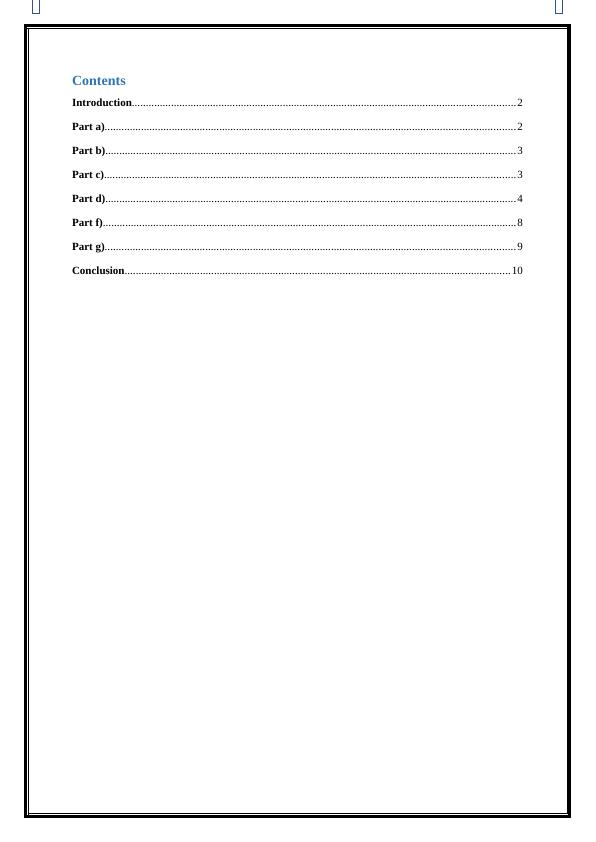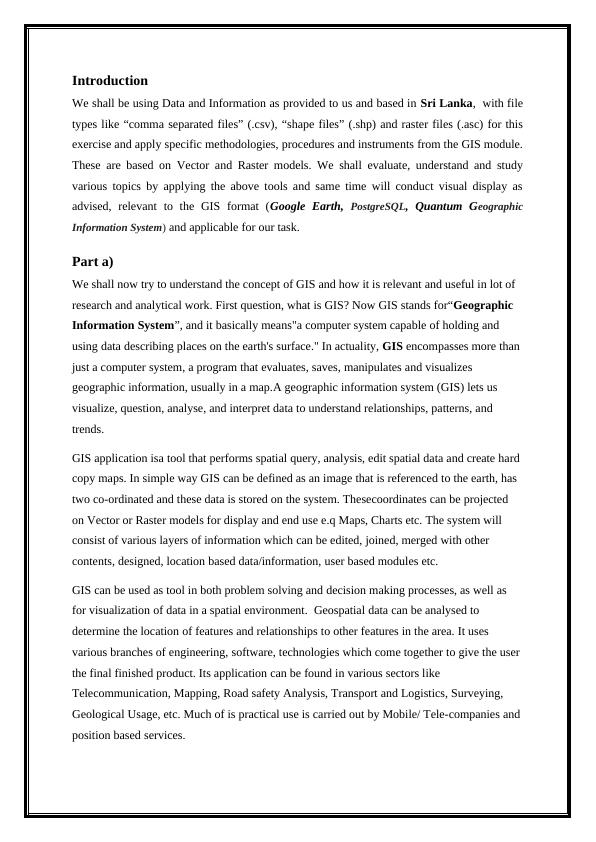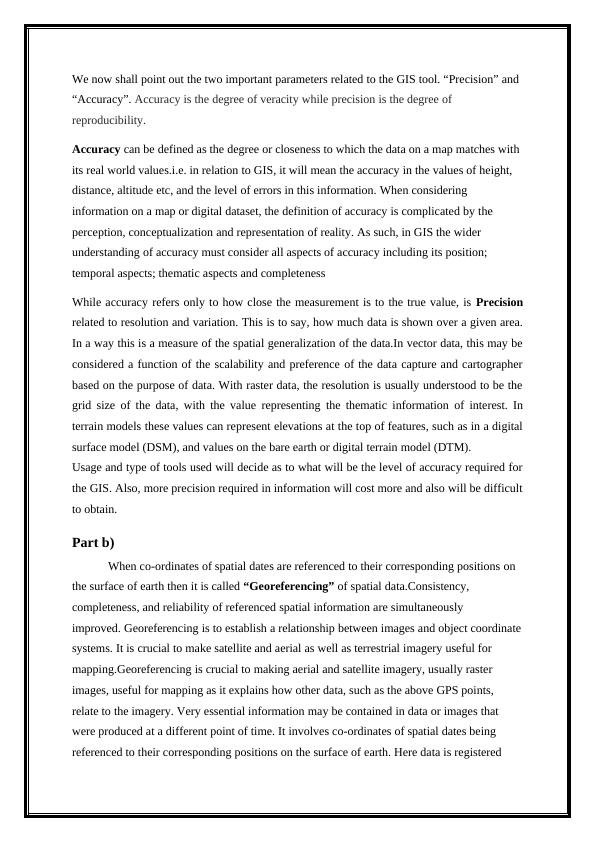Understanding GIS and its Applications
Added on 2023-01-19
14 Pages3900 Words53 Views
Dell
Business Intelligence
Business Intelligence

Contents
Introduction.........................................................................................................................................2
Part a)...................................................................................................................................................2
Part b)...................................................................................................................................................3
Part c)...................................................................................................................................................3
Part d)...................................................................................................................................................4
Part f)....................................................................................................................................................8
Part g)...................................................................................................................................................9
Conclusion..........................................................................................................................................10
Introduction.........................................................................................................................................2
Part a)...................................................................................................................................................2
Part b)...................................................................................................................................................3
Part c)...................................................................................................................................................3
Part d)...................................................................................................................................................4
Part f)....................................................................................................................................................8
Part g)...................................................................................................................................................9
Conclusion..........................................................................................................................................10

Introduction
We shall be using Data and Information as provided to us and based in Sri Lanka, with file
types like “comma separated files” (.csv), “shape files” (.shp) and raster files (.asc) for this
exercise and apply specific methodologies, procedures and instruments from the GIS module.
These are based on Vector and Raster models. We shall evaluate, understand and study
various topics by applying the above tools and same time will conduct visual display as
advised, relevant to the GIS format (Google Earth, PostgreSQL, Quantum Geographic
Information System) and applicable for our task.
Part a)
We shall now try to understand the concept of GIS and how it is relevant and useful in lot of
research and analytical work. First question, what is GIS? Now GIS stands for“Geographic
Information System”, and it basically means"a computer system capable of holding and
using data describing places on the earth's surface." In actuality, GIS encompasses more than
just a computer system, a program that evaluates, saves, manipulates and visualizes
geographic information, usually in a map.A geographic information system (GIS) lets us
visualize, question, analyse, and interpret data to understand relationships, patterns, and
trends.
GIS application isa tool that performs spatial query, analysis, edit spatial data and create hard
copy maps. In simple way GIS can be defined as an image that is referenced to the earth, has
two co-ordinated and these data is stored on the system. Thesecoordinates can be projected
on Vector or Raster models for display and end use e.q Maps, Charts etc. The system will
consist of various layers of information which can be edited, joined, merged with other
contents, designed, location based data/information, user based modules etc.
GIS can be used as tool in both problem solving and decision making processes, as well as
for visualization of data in a spatial environment. Geospatial data can be analysed to
determine the location of features and relationships to other features in the area. It uses
various branches of engineering, software, technologies which come together to give the user
the final finished product. Its application can be found in various sectors like
Telecommunication, Mapping, Road safety Analysis, Transport and Logistics, Surveying,
Geological Usage, etc. Much of is practical use is carried out by Mobile/ Tele-companies and
position based services.
We shall be using Data and Information as provided to us and based in Sri Lanka, with file
types like “comma separated files” (.csv), “shape files” (.shp) and raster files (.asc) for this
exercise and apply specific methodologies, procedures and instruments from the GIS module.
These are based on Vector and Raster models. We shall evaluate, understand and study
various topics by applying the above tools and same time will conduct visual display as
advised, relevant to the GIS format (Google Earth, PostgreSQL, Quantum Geographic
Information System) and applicable for our task.
Part a)
We shall now try to understand the concept of GIS and how it is relevant and useful in lot of
research and analytical work. First question, what is GIS? Now GIS stands for“Geographic
Information System”, and it basically means"a computer system capable of holding and
using data describing places on the earth's surface." In actuality, GIS encompasses more than
just a computer system, a program that evaluates, saves, manipulates and visualizes
geographic information, usually in a map.A geographic information system (GIS) lets us
visualize, question, analyse, and interpret data to understand relationships, patterns, and
trends.
GIS application isa tool that performs spatial query, analysis, edit spatial data and create hard
copy maps. In simple way GIS can be defined as an image that is referenced to the earth, has
two co-ordinated and these data is stored on the system. Thesecoordinates can be projected
on Vector or Raster models for display and end use e.q Maps, Charts etc. The system will
consist of various layers of information which can be edited, joined, merged with other
contents, designed, location based data/information, user based modules etc.
GIS can be used as tool in both problem solving and decision making processes, as well as
for visualization of data in a spatial environment. Geospatial data can be analysed to
determine the location of features and relationships to other features in the area. It uses
various branches of engineering, software, technologies which come together to give the user
the final finished product. Its application can be found in various sectors like
Telecommunication, Mapping, Road safety Analysis, Transport and Logistics, Surveying,
Geological Usage, etc. Much of is practical use is carried out by Mobile/ Tele-companies and
position based services.

We now shall point out the two important parameters related to the GIS tool. “Precision” and
“Accuracy”. Accuracy is the degree of veracity while precision is the degree of
reproducibility.
Accuracy can be defined as the degree or closeness to which the data on a map matches with
its real world values.i.e. in relation to GIS, it will mean the accuracy in the values of height,
distance, altitude etc, and the level of errors in this information. When considering
information on a map or digital dataset, the definition of accuracy is complicated by the
perception, conceptualization and representation of reality. As such, in GIS the wider
understanding of accuracy must consider all aspects of accuracy including its position;
temporal aspects; thematic aspects and completeness
While accuracy refers only to how close the measurement is to the true value, is Precision
related to resolution and variation. This is to say, how much data is shown over a given area.
In a way this is a measure of the spatial generalization of the data.In vector data, this may be
considered a function of the scalability and preference of the data capture and cartographer
based on the purpose of data. With raster data, the resolution is usually understood to be the
grid size of the data, with the value representing the thematic information of interest. In
terrain models these values can represent elevations at the top of features, such as in a digital
surface model (DSM), and values on the bare earth or digital terrain model (DTM).
Usage and type of tools used will decide as to what will be the level of accuracy required for
the GIS. Also, more precision required in information will cost more and also will be difficult
to obtain.
Part b)
When co-ordinates of spatial dates are referenced to their corresponding positions on
the surface of earth then it is called “Georeferencing” of spatial data.Consistency,
completeness, and reliability of referenced spatial information are simultaneously
improved. Georeferencing is to establish a relationship between images and object coordinate
systems. It is crucial to make satellite and aerial as well as terrestrial imagery useful for
mapping.Georeferencing is crucial to making aerial and satellite imagery, usually raster
images, useful for mapping as it explains how other data, such as the above GPS points,
relate to the imagery. Very essential information may be contained in data or images that
were produced at a different point of time. It involves co-ordinates of spatial dates being
referenced to their corresponding positions on the surface of earth. Here data is registered
“Accuracy”. Accuracy is the degree of veracity while precision is the degree of
reproducibility.
Accuracy can be defined as the degree or closeness to which the data on a map matches with
its real world values.i.e. in relation to GIS, it will mean the accuracy in the values of height,
distance, altitude etc, and the level of errors in this information. When considering
information on a map or digital dataset, the definition of accuracy is complicated by the
perception, conceptualization and representation of reality. As such, in GIS the wider
understanding of accuracy must consider all aspects of accuracy including its position;
temporal aspects; thematic aspects and completeness
While accuracy refers only to how close the measurement is to the true value, is Precision
related to resolution and variation. This is to say, how much data is shown over a given area.
In a way this is a measure of the spatial generalization of the data.In vector data, this may be
considered a function of the scalability and preference of the data capture and cartographer
based on the purpose of data. With raster data, the resolution is usually understood to be the
grid size of the data, with the value representing the thematic information of interest. In
terrain models these values can represent elevations at the top of features, such as in a digital
surface model (DSM), and values on the bare earth or digital terrain model (DTM).
Usage and type of tools used will decide as to what will be the level of accuracy required for
the GIS. Also, more precision required in information will cost more and also will be difficult
to obtain.
Part b)
When co-ordinates of spatial dates are referenced to their corresponding positions on
the surface of earth then it is called “Georeferencing” of spatial data.Consistency,
completeness, and reliability of referenced spatial information are simultaneously
improved. Georeferencing is to establish a relationship between images and object coordinate
systems. It is crucial to make satellite and aerial as well as terrestrial imagery useful for
mapping.Georeferencing is crucial to making aerial and satellite imagery, usually raster
images, useful for mapping as it explains how other data, such as the above GPS points,
relate to the imagery. Very essential information may be contained in data or images that
were produced at a different point of time. It involves co-ordinates of spatial dates being
referenced to their corresponding positions on the surface of earth. Here data is registered

End of preview
Want to access all the pages? Upload your documents or become a member.
Related Documents
GIS and Environmental Management.lg...
|12
|2075
|36
Georectification: A Study on Using Erdas Imagine for Spatially Accurate Mappinglg...
|18
|1692
|48
GIS Environmental Management | Assignmentlg...
|14
|1428
|17
Geospatial Analytics Use cases - Assignmentlg...
|13
|3869
|18
Map Design for Geospatial Science Reportlg...
|6
|1917
|359
Geographical Information System: Assignmentlg...
|4
|1154
|324
